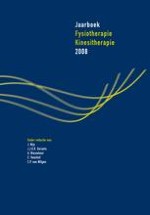Samenvatting
Op vele fronten is de plasticiteit van het zenuwstelsel aangetoond, ook bij volwassenen. Beeldvormende technieken als fMRI en PET-scans laten zien dat de representaties van het menselijk lichaam in het brein ingrijpend kunnen veranderen bij herstel na hersenbeschadiging, maar ook onder invloed van training en therapie. Behalve onderzoek naar de effecten van therapieën (evidence based therapy) vindt ook een conceptuele ontwikkeling plaats: in toenemende mate wordt duidelijk dat uiteenlopende manieren van aanpak op een specifieke en unieke manier kunnen aangrijpen op de neurale plasticiteit. De tijd van die ene ideale methode of standaardbehandeling lijkt daarom definitief voorbij. Dit hoofdstuk beschrijft interventies die de fysiotherapeut kan gebruiken: stimulatie, operant leren, biofeedback, imitatieleren, de sagittale spiegel, mentaal oefenen, de dubbeltaakaanpak, forced use, backward chaining, oefenvariatie, verbale zelfsturing en foutloos leren. Van ieder principe of methode wordt een voorbeeld gegeven. Zo kan de fysiotherapeut zijn therapeutische repertoire aanzienlijk vergroten. We hebben vooral een keuzeprobleem: welke therapie, bij welke patiënt, wanneer en waarom?
